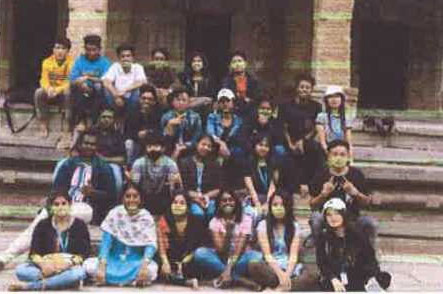
Industrial Vist
Date: 7th February 2020
Class & No. of students: VI BA JPENG A Section - 50 Students
Places Visited: Janapada Loka, Ramanagara
Name and details of any external agencies/contacts involved: Nil
The students visited Janapada Loka, the folk-art museum situated in Ramanagara on 7th February 2020. Janapada Loka exhibits the life style of village folk of Karnataka and different types of musical instruments, tools used in agriculture and farming. The shadow puppets on display are 500 years old. Loka Mahal, a wing in the museum has a display of 5,000 folk artifacts. Chitra Kuteera commemorates the museum's founder H L Nage Gowda. Doddamane or "big house" is a replica of a large traditional village house. ‘Ayagaramala’ is an open yard which gave an exposure to the rural lifestyle with sculptures of working man, household and rural utensils. The visit enabled the students to relate to the concepts of Optional English VII discussed in the classroom.
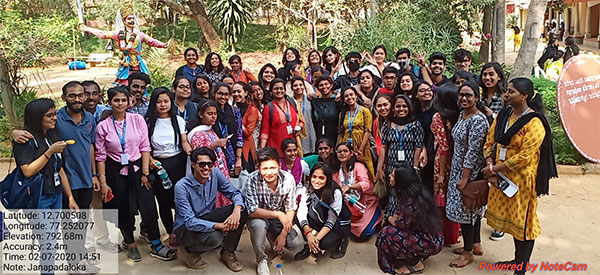
Date: 7th February, 2020
Class and Section: II Semester JPEng B Section
No. of students: 60 Students
Places Visited:
1. Big Banyan Tree, Tavarekere
2. Janapada Loka, Ramanagara
Name and details of any external agencies/contacts involved: NA
The field trip was organized on 7th February, 2020. The first place that we visited was the Dodda Aalada Mara literally translated to Big Banyan Tree, located in the village of Kethohalli in the Bangalore Urban district of Karnataka, India. The students were excited to see the giant 400-year-old banyan tree.
The second place we visited was Janapada Loka, which is a folk museum that has an exclusive display of the village folk arts of Karnataka. It is under the aegis of the Karnataka Janapada Parishat. Loka Mahal, a wing in the museum has a display of 5,000 folk artifacts. It is situated in Ramanagara, Ramanagara district in the Indian state of Karnataka. Janapada Loka is divided into separate wings — Folk arts museum, Loka Mahal, Chitra Kuteera, Doddamane, Shilamala, Arghyamala etc. The visit helped the students to relate to the concepts of English II taught during the classroom sessions. The students were mesmerized with the artifacts used in the 1980s and the culture and customs of the time.
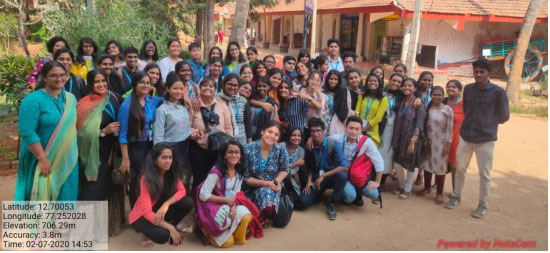
Date: 31.01.2020
Class & No. of Students: II Semester and IV Semester BA JPsENG, 89 Students
Places Visited:
1. Gandhi bhavan
2. Janapada Loka
Gandhi Bhavan is the museum set up in the place where Gandhi used to take strolls. It was initially known as Gandhi Smaraka Nidhi under chairmanship of Rajendra Prasad. In 1965, it was renamed as Gandhi Bhavan and was inaugurated by S. Radhakrishnan. At that time, the museum's land was in its possession in form of lease. Later Sri Ramakrishna Hegde, during his tenure as the Chief Minister of Karnataka donated the land to Gandhi Bhavan. The main aim of Gandhi Bhavan was to propagate Gandhian philosophies and ideals among the people of the state, especially among the youth. Janapada Loka or "Folk world" or "Folk-culture World" is a folk museum that has an exclusive display of the village folk arts of Karnataka. It is under the aegis of the Karnataka Janapada Pari shat. Loka Mahal, a wing in the museum has a display of 5,000 folk artifacts. It is situated in Ramanagra, Ramanagra district in the Indian state of Karnataka, on the Bangalore-Mysore highway.
H.L Nage Gowda, an Indian civil servant and folklorist thought of creating a museum to exhibit the varied folk art and culture of Karnataka.
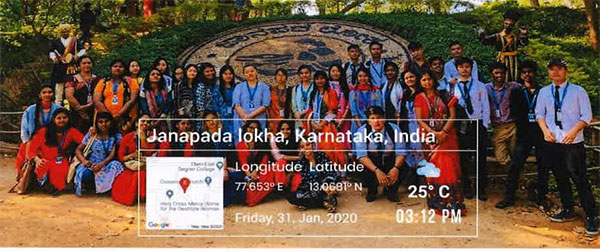
Date: 27.01.2020
Class & No. of students: VI BA JPCS - 32 Students
Place Visited: Janapada Loka
Name and details of any external agencies/contacts involved: Nil
Janapada Loka or “Folk world" or ”Folk-culture World" is a folk museum that has anexclusive display of the village folk arts of Karnataka. It is under the aegis of the Karnataka Janapada Parishat. Loka Mahal, a wing in the museum has a display of 5,000 folk artifacts. It is situated in Ramanagara district in the Indian state of Karnataka, on the Bangalore-Mysore highway, to the south of Bangalore. Janapada Loka is divided into separate wings — Folk arts museum, Loka Mahal, Chitra Kuteera, Doddamane, Shilamala, Arghyamala etc. The museum has a collection of 5,000 folk artefacts, was first established on 21 March 1979 with the objective to promote, conserve, propagate and document Folk traditions of Karnataka. The visit could also connect to few concepts taught in Journalism VII during the classroom sessions.
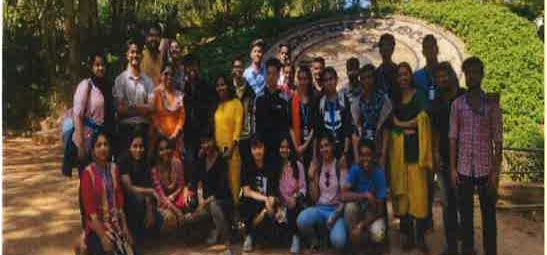
Date: 27/01/2020
Class and Section: IV Semester BA HTJ
Number of beneficiaries: 24 Students
Objective: To expose the students to the folk culture world.
Place Visited:
1. Janapada Loka
Janapada Loka is a folk culture world with lots of beautiful folk arts which displayed the Village folk arts of Karnataka. Janapada Loka Is divided into separate wings — Folk arts museum, Loka Mahal, Chrtra Kuteera, Doddamane, Shilamala, Arghyamala etc. The museum has a collection of 5,000 folk artefacts.The Founder of the museum is H. L. Nage Gowda, by profession and also a folklorist, who after retirement, made it his lifetime goal. The main area of interest in the Janapada Loka is the folk arts museum, which displays large number of artifacts of the folk culture, along with different types of musical instruments, tools used in agriculture and farming. The shadow puppets on display are 500 years old and it also houses a plethora of rural artifacts which bring out the theme of folk literature, music, dance, festivals, sculpture and lifestyle.
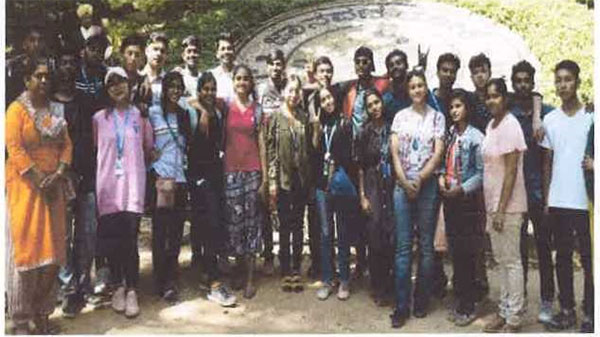
Date: 23/1/2020
Class & No. of students: IV JPENG A Section - 56 Students
Place of Visit: Thrithwa Ashram
Thrithwa Ashram a voluntary organization for the novel mission of rendering God’s love and care to the least, the last and lost. This organization was run by nuns. The nuns were very helpful and shared their experiences and the stories of the patients. There are 38 schizophrenic patients from different parts of India. Students were oriented how to conduct the program and have interactive session with at least 2 patients. The patients were very open and welcoming to conversations and interacting with us but few patients were very hesitant and didn’t interact. The session started with worship song and prayer. Students moved around and conducted an individual session with each patient. Patients started talking to students enthusiastically and they enjoyed conversing with students. They shared about their feelings, thoughts and basic details. The place had a very homely feeling and everyone lived together like a family, supporting with each other. The visit gave a hands-on exposure to the concepts of Psychology IV- Developmental Psychology taught in classrooms. Finally, the program ended with prayer and some entertainment, songs and dance, some patients enjoyed dancing with students.
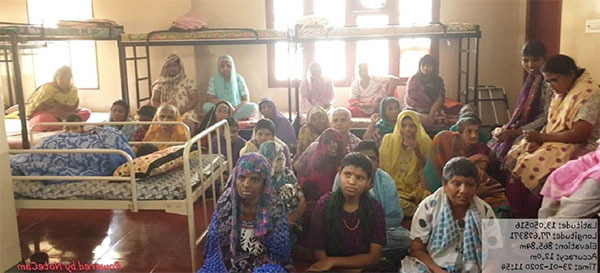
Date: 23/01/2020
Class & No. of students: II BA JPEng A Section - 57 Students
Places Visited: Trithwa Ashrama , Bangalore
Name and details of any external agencies/contacts involved: (Sr. Elishwamma D E C, Superior, Thrithwa Ashrama)
The students of II semester JPEng‘A’ along with the Class Animator, Dr.Pauline V N, visited Trithwa Ashram, an old age home located in Thanisandra Main Rd, Bengaluru. The class consisting of 57 students along with the Class Animator reached the organization approximately at 2.00 PM and were welcomed by the caretaker of the organization Sr.Elishwamma, a person of unique abilities and mental strength. The students interacted with the inmates and they remembered and shared the memories of their life. The students conducted games, performed and sang in order to engage the old age people with happiness and enjoyment. The visit helped the students to get a practical exposure on the concepts taught in Psychology II Theories and Experiments. Students contributed food and snacks for the old age people in the home.
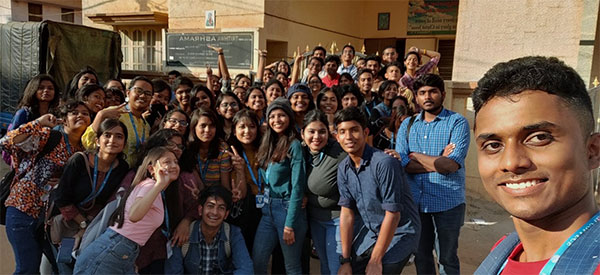
Date: 10th January 2020
Class & No. of students: VI BA JPENG B Section – 51 Students
Places Visited: Janapada Loka
Name and details of any external agencies/contacts involved: Nil
Janapada Loka (Folk World) was established on 21 March 1979 by H. L. Nage Gowda and it is located in Ramanagara District, Karnataka on the Bangalore Mysore highway. It is a folk museum that has an exclusive collection and display of the village folk arts of Karnataka. Apart from museum there are statues of Yakshagana, Veergase artists and also sculptures of working men and women who are engaged in various work in a village set up. This place truly promotes the hardcore folk and folk forms of Karnataka for the future generation. The visit enabled the students to connect to the concepts of Optional English VII discussed in the classroom.
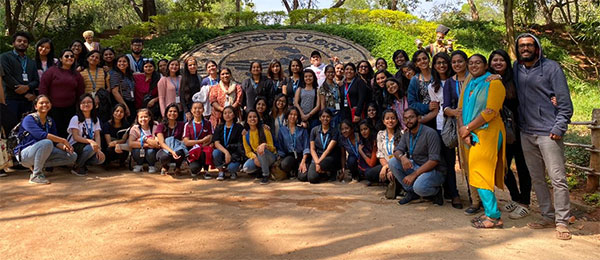
Date: 10/01/2020
Class & No. of students: II BA JEEng - 28 Students
Place Visited: Janapada Loka
Name and details of any external agencies/contacts involved: Nil
The students of II semester JEEng along with the Class Animator, A Anusha, visited Janapada Loka, a folk museum that exclusively portrays the village folk arts of Karnataka located in Ramanagara, Bengaluru. The class consisting of 30 students along with the Class Animator reached the organization approximately at 10.00 AM and were guided by the caretakers of the museum, with elaborate description on each folk art and the ancient way of living. The students got a better understanding of the folk arts, culture, tradition and the ancient way of living. The visit enabled the students to relate to various concepts taught in Optional English II during classroom hours.
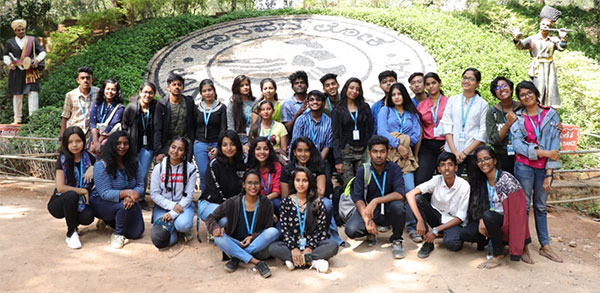
Date: 9/01/2020
Class & No. of students: IV BA JPENG B - 54 Students
Places Visited: Janapada Loka, Ramanagara
Name and details of any external agencies/contacts involved: Nil
The students visited Janapada Loka, the folk art museum in Ramanagara on 9th January 2020. It is a folk museum that has an exclusive display of the village folk arts of Karnataka. It is under the aegis of the Karnataka Janapada Parishat. It shows the life style of village life in Karnataka and different types of tools and ancient equipment used in the field of agriculture. The Janapada Loka campus consists of a short road with display of mannequins of folk artists, symbols of traditional tribal worship, Lokamatha Mandira, Loka Mahal, Chitra Kuteera, Janapada Library, Shilamala, Ayagaramala, puppet theater, open air theater and Loka Sarovara or lake. The visit helped the students to connect to the concepts of English IV taught during the classroom hours.

Date: 9/01/2020
Class & No. of students: IV BA JEENG - 27 Students
Places Visited:
1. Big Banyan Tree
2. Janapada Loka, Ramanagara
Name and details of any external agencies/contacts involved:
Janapada Loka, Ramanagara
The class first visited Big Banyan Tree (Ficus Benghalensi), a giant approximately 400-year-old banyan tree located in the village of Kethohalli in the Bangalore Urban district of Karnataka. This single plant covers 3 acres (12,000 m2) and is one of the largest of its kind.
The group then visited Janapada Loka. It means a "Folk world" or "Folk-culture World." It is a folk museum of village folk arts of Karnataka. It exhibits different types of musical instruments, tools used in agriculture and farming. The shadow puppets on display are 500 years old. Loka Mahal, a wing in the museum has a display of 5,000 folk artifacts. It is situated in Ramanagara, on the Bangalore-Mysore highway. Chitra Kuteera commemorates the museum's founder H L Nage Gowda. Doddamane or "big house" is a replica of a large traditional village house. The visit enabled the students to reflect on various concepts taught in English IV during classroom sessions.
Objectives:
1. To show the students to the artifacts of the folk culture of Karnataka
2. To develop interest in them to know more about the people and their art.
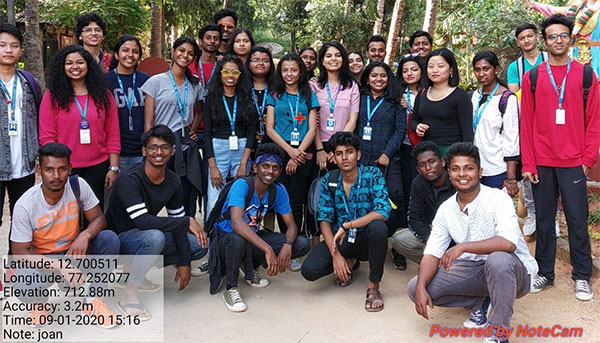
Date: 07/01/2020
Class & No. of students: II Sem and IV Sem EPsS, 57 students
Places Visited:
1. Devanahalli Fort
2. Bhoga Nandishwara temple
3. Shri Shri Nakoda Avanti 108 Parshwanath Jain Thirth Dam
Name and details of any external agencies/contacts involved: Nil
We started our trip at 8.50 am from the college. It took almost an hour to reach the first destination, Devanahalli Fort. It’s a living fort and we can see only the remains of fort walls. The history of fort dates back to 15th century. The students were briefed on the historical importance of the fort, also the social causes behind the scene of construction. While exploring the fort students could learn about the living society and their major productions. The second place of visit was Bhoga Nandishwara temple, which represents Indian traditions. Students were explained how temples were places of art and culture at a time. The visual beauty of the temple is still preserved. The last place of visit was Shri Shri Nakoda Avanti 108 Parshwanath Jain Thirth Dam. The Jain society’s culture was explained to students. The visit enabled the students of second Semester and fourth Semester to connect to the concepts of Sociology II and Sociology IV respectively, taught in the classrooms. Student’s interaction with people in the temple was more effective.
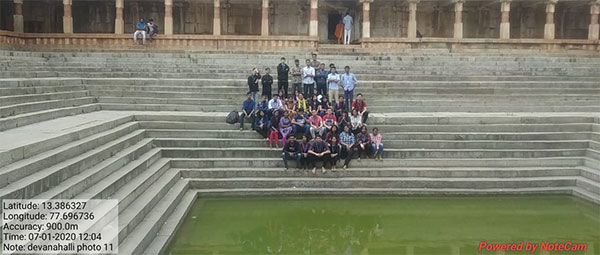
Date: 25.09.19
Class & No. of Students: VI SEM B.A JPSENG, 42 Students
Places Visited: Sriramanhalli village (Rajankunte)
The department of political science arranged a field visit to Sriramanhalli village on September 25th 2019 for the students of final year BA (JPsEng). The programme consisted of talks by members of the village Panchayat, an interactive session with the students and a walk through various departments run by the Panchayat like - the school, stitching center, canteen and catering services and organic farming land which is aided by the Panchayat.
Students had practical exposure of Local Self Government which is a part of their curriculum in Public Administration. They had an opportunity to meet all the Panchayat members and Ex Panchayat member and discussed over the various issues. During their discussion students learnt that education is provided for free, women manufacture sanitary pad and the profit is shared among women.
Students also noticed the segregation of wet and dry waste and proper drainage channels which ensured the cleanliness of the village. Initiatives like cycles for rent to spread an awareness of air pollution are also running successfully at the place. A digital library is also introduced by them. Another innovative measure to help the needy is they collect clothing and other necessities at place where people can pick and drop in as per their need and convenience. All of it does sound like a Utopian Universe but it really is in implementation which was witnessed by the students. These measures are put into practice with the help of committees and sub-committees which is a clear example of the political concept, decentralized administration. Panchayat members- Mr.Doddayalappa, Mr. Manjuath, Ms. Shobha and former Panchayat member Mr. Manjunath, Mr. Ramaswamy, Programme Director, Prof. Sangayya Swamy (Resource Person).

Date: 06/12/19
Class and No. of Students: IV Semester and VI Semester BA HEP – 77 Students
Places Visited:
1. Sravanabelagola: Chandragiri and Vindyagiri Hills
2. National Institute of Prakrit Studies, Sravanabelagola
Objective:
1. To introduce to the students the rich architectural heritage of the place.
2. To highlight the significance of manuscripts as a source of history writing
The Department of History organized a one-day trip to Sravanabelagola and the National Institute of Prakrit Studies on 06/12/19 for the IV and VI BA HEP students. The journey started at 6 am from the college campus. The first stop was the Chandragiri and Vindyagiri Hills in Sravanabelagola. Students explored the Chandragiri hills first where they came across number of inscriptions carved on the stone surface of the hills. The accompanying teachers highlighted the architectural genius of the 58 feet high monolithic Gomateshwara statue and narrated the history behind it. The students then proceeded to the Vidhyagiri Hills and very excited to see what they had learnt in their Karnataka history paper coming alive. The historical narratives of the various basadis located on this hill were explained to them. They were also informed about the inscriptions present there.
The group then headed to the National Institute of Prakrit Studies, where they had a workshop on the significance of manuscripts as a source to understanding history. The students got an opportunity to interact with faculties and researchers of the institute. The visit enabled the students to connect to the concepts taught in History during the classroom sessions.
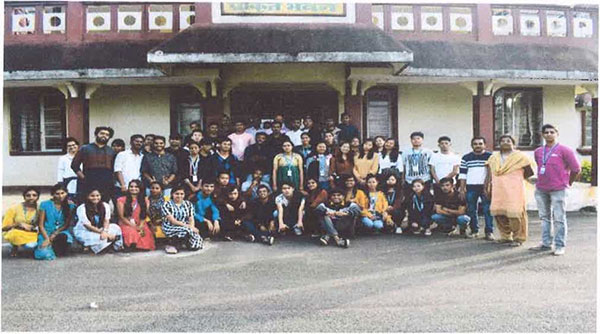
Date: 04.12.19
Class and Section: II Semester BA HEP
Number of beneficiaries: 45 Students
Places visited:
1. Devanahalli Fort
2. Venugopalaswamy Temple, Devanahalli Fort
3. Bhoga Nandeeshwara Temple
4. Bharat Ratna Sir M Visvesvaraya Musuem, Muddenahalli
5. Shri Shri Nakoda Avanti Jain Temple
Objective: To expose the students to the world of historically important architectural marvels in Bangalore city
The Department of History organized a one-day trip for the II BA HEP students to the above-mentioned places on 04/12/19. The journey started from the college campus at 9 am and the first stop was the Devanahalli Fort. The students were explained the historical significance of the fort and the fact that it is one of the rarest living forts in India was also highlighted. The walk through the fort complex introduced the students to the military driven arrangement of the fort by pointing to the various elements present such as the battlement. The walk also led the students to explore the Venugopalaswamy temple complex inside the fort. Students were able to identify that this temple was one of the oldest among the temples present inside the fort complex. It was explained to them that the courtyard, with a Garuda Stamba, was one of the most spacious one and that the walls of the temple depict various scenes from Ramayana and the feats of Lord Krishna as a child, and that the pillars have beautiful statues carved on them.
The journey continued and made a halt at the Bhoga Nandeeshwara temple. The original temple in the complex was told to the students that it was one of the oldest temples of Karnataka and that it dated back to the early 9th century. The students were thrilled to learn from the Archaeological Survey of India’s tablet that the construction of the temple for Shiva is credited to the Nolamba dynasty ruler Nolambadiraja and the Rashtrakuta emperor Govinda III.
The group then proceeded to the Bharat Ratna Sir M Visvesvaraya Musuem located at Muddenahalli. The students spent time in the museum being inspired by the life and works of one of the greatest Gems of Karnataka, which the Department had already introduced to them earlier this year in a series of lecture. The visit enabled the students to connect to the concepts taught in History during the classroom sessions.
Before returning to college the group made a final stop at the Shri Shri Nakoda Avanti Jain Temple located near the Devanahalli Fort to know the contribution of Jainism to the state of Karnataka.
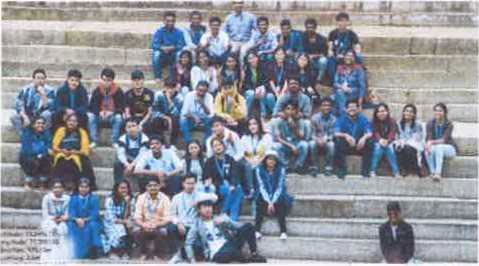
Date: 03.12.2019
Class & No. of students: IV BA JPCS - 50 Students
Places Visited:
1.Namma Dhwani, Budikote, Kolar
2.Hyder Ali Birthplace
Name and details of any external agencies/contacts involved: Community Managed Resource Centre (CMRCs) promoted by MYRADA
Fifty students from IV semester BA JPCs visited Namma Dhwani, Community Radio station located at Budikote, Kolar on 03 December 2019. The visit was a part of the field visit and it helped students to get experience on the radio journalism as a part of their syllabus. NAMMA DHWANI COMMUNITY RADIO STATION, 90.4MHz is established in Bodikote. This community radio was jointly set up by VOICE and MYRADA [Mysore Resettlement and Development Agency.
Vishwanatha Reddy, a representative from the community radio station addressed the students and briefed them about the history of the station and its significance in the life of people. The radio station and their scheduled programmes starts from 7am. They start with devotional songs from 7am to 7:30am. Then continue with the agriculture related program called “Krushi Kushi” till 8am. It is followed by Grama Dharshana and folk song programmes.
The second schedule starts with folk songs from 12pm and continues with Jnana Gurukula, a program which is related to education and knowledge, & Kanunu Svandane related to Government Laws.
The evening schedule has eight programmes. The programmes touch up on all aspects of development for the people. Such as Trains report, News, Market news/price, Keerthanegalu [the psalms] and so on. Students got hands on experience to sing songs and read out news on live during the visit. It was followed by a shot stop near Hyder Ali’s Birthplace at Budikote. The visit to these places enabled the students to understand several concepts of Journalism IV taught in the classroom. Students enjoyed the scenic view as well as understood about significance of a historical leader from Karnataka
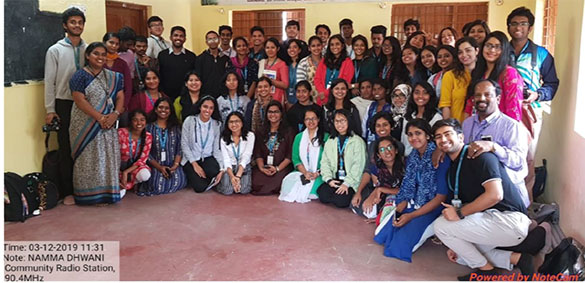
Date: 2.12.2019
Class & No. of students: II BA JPCS - 50 Students
Place Visited:
1. Dodda Alada Mara or The Big Banyan Tree
2.Janapad Loka, Ramanagara
Name and details of any external agencies/contacts involved: Nil
Dodda Alada Mara or The Big Banyan Tree is a giant banyan tree which approximately is around 400 years old. That was our first place of visit. It is spread around 3 acres of land. But the main root of tree is no more there due to natural disease. The second place of visit was Janapad Loka. Janapad loka had three mandapas namely; The lokamatha mandir,Loka mahal,Chitra kuteera. The lokamatha mandir had exhibits of ancient rural household items and agricultural tools. The loka mahal had exhibits of large dolls of artist that performed the yakshagana and life size dolls of koduva couples and puppetry. The chitra kuteera had photographs portraying different tribes and tribal lifestyles. It also commemorates H L Naga Gowda and his life history along with his works is exhibited. The visit could also connect to few concepts taught in Journalism II during the classroom sessions.
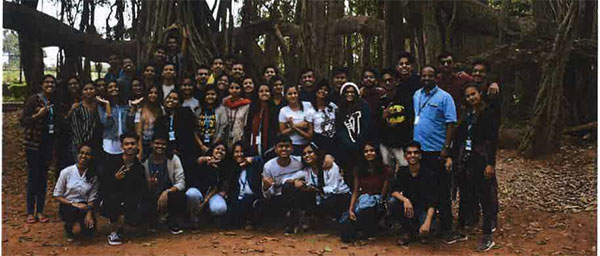
Class and Section: II Semester and V Semester BA HTJ
Number of beneficiaries: 44 Students
Objective: To expose the students to the world of historically important architectural marvels in the country.
Place Visited:
1. Chennakesava Temple, Somnathpur
Observations of the place of visit
The Chennakesava Temple, also referred to as Chennakeshava Temple, Keshava Temple or Kesava Temple, is a Vaishnava Hindu temple on the banks of River Kaveri at Somanathapura, Karnataka, India. The temple was consecrated in 1258 CE by Somanatha Dandanayaka, a general of the Hoysala King Narasimha III. It is located 38 kilometres (24 mi) east of Mysuru city Out of the 3 idols in the 3 sanctum sanctorums, the idol of Janardhana Venugopala is damaged and this second idol has been re-installed after being removed. The superstructure of the temple is crowned with a stupi. Around the temple is an open courtyard enclosed by cloistered prakara mantapa with pillars. The three garba grihas have the presiding deities of ‘Prasanna Kesava’ on the west, ‘Varada Janardana’ on the north and ‘Gandapendaara Gopala’ on the south (as named in the temple inscriptions). According to the ASI, the original idol of Kesava went missing and was later replaced. It was marvellous Keshava temple of Hoysala architecture and is one of the heritage properties which has been maintained nicely. Photos and videos were not restricted and students enjoyed clicking photos at its best. The students looked at the temple and appreciated the people who had worked on rock and created a beautiful monument.
